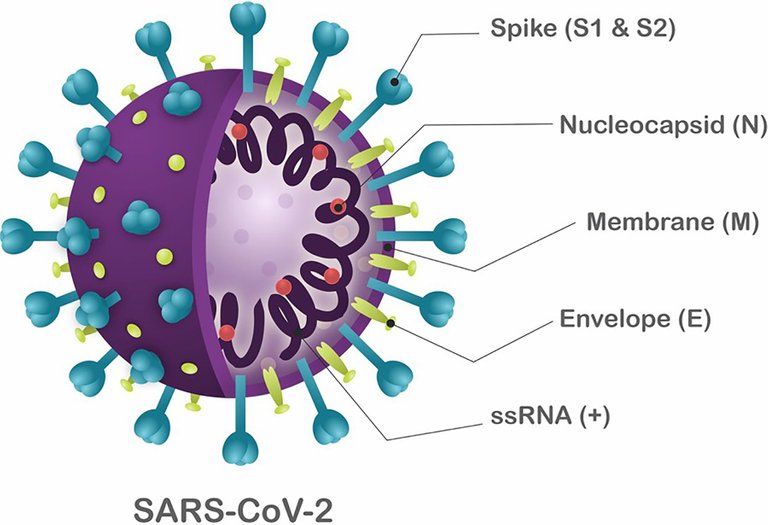Covid 19 || SARS-CoV-2 Pathophysiology and Pathogenesis
The Covid-19 pandemic is one pandemic that the world didn't plan for and so wasn't prepared for. Lots of lives were lost, and so many people fought for their lives on sick beds even with ventilators. We know that Covid-19 is caused by the coronavirus, but it is specifically caused by the SARS-Cov2. The virus possesses specific proteins in its outer structure, and these proteins are the Spike protein, the Hemagglutinin Esterase Protein, these two proteins are important in attaching to the host cells with the protein Angiotensin Converting Enzyme 2 (ACE 2) and then allows the virus to enter into the cells. Other proteins on the virus are the M-protein, Envelope (E-protein). In the Virus is the Envelope itself which is a bi-layer, and inside the cell is a nucleocapsid protein, and he Viral nucleic acid. Viral nucleic acids can be DNA or RNA, they can be single or double, and in the case of SARS-Cov2, it is a single-stranded RNA (positive-sense single-stranded RNA).1, 2, 3..

The SARS-Cov2 virus and the Bat Coronavirus (RATG13) have over a 90% genetic similarity,4 so if people say that the virus was transferred from a Bat to Human, then it could be justified looking at the percentage. The possibility that it has an intermediary host, and the Bat coronavirus infects the intermediary and adds some genetic material that allows it to infect humans in a process known as Homologous Recombination where genetic materials were swapped with the intermediate host, giving them the characteristics.5, 6, 7. The virus can come in the S-type and the L-type, with the 'S' type of SARS-Cov2 responsible for the infection of about 30% of people while the "L" type accounts for about 70% of all infections. The "S" types are also believed to give less severe and aggressive symptoms, while the "L" types are more severe and more aggressive. 8, 9, 10.
The rate of transmission of the SARS-Cov2 Virus is dependent on two things, R0 (the reproductive ratio) and SI (Series Interval). The reproductive ratio is the ability of the virus to be passed from one individual to another people, and SARS-Cov2 has a reproductive ratio (R0) of 2 to 4. The Series interval is the time taken for an infected individual to pass the virus to another person, and this is with respect to symptomatic patients. The mean interval for this to occur is 4 days, so it takes about 12 days for a person to infect 3 direct groups of people, and there keeps to be an exponential growth in the number of people infected.11, 12.
It has been shown that SARS-Cov2 which is responsible for Covid-19 can be transmitted through Respiratory droplets which could be sneezing, coughing, and body fluid. The virus can Aerosolize within a particular environment for about 3 hours, and it can travel for up to 25ft or more in less than 1 second. The virus can stay on fomite for as long as 72 hours.13, 14, 15, 16 The SARS-Cov2 virus uses its Spike Protein and Hemagglutinin Esterase Protein to bind to the ACE-2 receptor in the type 2 pneumocytes which is found in the lungs of the host. Also, the transmembrane serine protease type 2 (TMPRSS2) which is a surface protein in the respiratory and digestive tracts that allows the virus to enter into the cell of the host. The virus penetrates into the cell through endocytosis. In the type 2 pneumocyte, it releases its positive-sense single-stranded RNA into the cytoplasm which binds on both free ribosomes and those bound to the rough endoplasmic reticulum. The bindings lead to the release of poly-proteins which are used to make the proteins needed by the virus for binding, as well as other proteins it needs in a new virus structure. It also produces the RNA-Dependent RNA Polymerase enzyme which takes the virus RNA to create more RNA. In simple words, the virus is using the host cells to make more of its structure. These materials are then transported to the Golgi for packaging to create new viruses. The virus then gets released out of the cell through exocytosis leaving the cell of the host dead.17, 18, 19. When the alveolar cells are damaged, they start to release molecules which include interferons, the alpha and beta interferons. They start to increase the synthesis of antiviral peptides to break down the virus. They also produce Damage Associated Molecular Patterns (DAMPs) and inflammatory cytokines which alerts an alveolar macrophage in the vicinity which the secrete inflammatory mediators which include Interleukin-1, Interleukin-6, Interleukin-8, TNF-alpha, and Gamma interferons, causing spaces between the pulmonary capillary area and allowing the loss of fluid from the capillary spaces called interstitial edema and alveolar edema, causing low oxygen in the blood called hypoxemia, and then CO2 starts to build in the blood known as hypercarbia. This can then lead to respiratory acidosis.20, 21, 22, 23, 24.
SARS-Cov2 can affect the olfactory and gustatory cells, leading to anosmia as well as decreased gustation. It also affects the mucosal of the pharynx leading to pharyngitis. In the lung, it induces viral pneumonia which becomes an acute respiratory distress syndrome which will then progress to become systemic inflammatory response syndrome and multi-system organ failure leading to decreased cardiac function (cardiomyopathy).25, 26, 27, 28.
This multi-system organ failure can lead to kidney failure and other organs including the gastrointestinal tract. In my next post, I will be looking at its association with Vitamin D deficiency, diagnosis of Covid-19, and vaccines.
Thanks for your contribution to the STEMsocial community. Feel free to join us on discord to get to know the rest of us!
Please consider delegating to the @stemsocial account (85% of the curation rewards are returned).
Thanks for including @stemsocial as a beneficiary, which gives you stronger support.